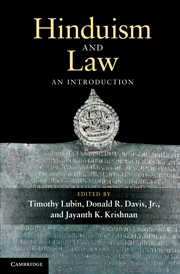Book contents
- Frontmatter
- Contents
- List of contributors
- Acknowledgements
- Chronology
- Abbreviations
- Map South Asia: political divisions c. 1860 and today
- Introduction
- Part I Hindu law
- Part II Law in ancient and medieval Hindu traditions
- Chapter 7 Hindu jurisprudence and scriptural hermeneutics
- Chapter 8 Indic conceptions of authority
- Chapter 9 Śūdradharma and legal treatments of caste
- Chapter 10 Law, literature, and the problem of politics in medieval India
- Chapter 11 Hindu law as performance
- Part III Law and modern Hinduism
- Glossary
- Bibliography
- Index
Chapter 9 - Śūdradharma and legal treatments of caste
Published online by Cambridge University Press: 05 June 2012
- Frontmatter
- Contents
- List of contributors
- Acknowledgements
- Chronology
- Abbreviations
- Map South Asia: political divisions c. 1860 and today
- Introduction
- Part I Hindu law
- Part II Law in ancient and medieval Hindu traditions
- Chapter 7 Hindu jurisprudence and scriptural hermeneutics
- Chapter 8 Indic conceptions of authority
- Chapter 9 Śūdradharma and legal treatments of caste
- Chapter 10 Law, literature, and the problem of politics in medieval India
- Chapter 11 Hindu law as performance
- Part III Law and modern Hinduism
- Glossary
- Bibliography
- Index
Summary
Introduction
Śūdradharma, literally, dharma for the Śūdra, is an old topic in the Dharmaśāstra, part of the standard list of topics in dharma texts from the earliest period. From 1350 to 1700 ce we find a number of texts in the genre of the dharma-nibandha (digest on dharma), devoted wholly and solely to the topic of śūdradharma. We are able to locate several of these texts, especially those produced between 1550 and 1680 ce, a period conventionally designated as late medieval, though it is increasingly referred to as early modern. I call this corpus the “Śūdra archive” (Vajpeyi 2004). The dharma-nibandha was a genre of text produced profusely, with much royal patronage, all across Deccan India from the early twelfth to the late sixteenth century (Table 1). As the name of the genre indicates, these texts were compendia of earlier materials on various topics in dharma. The śūdradharma-nibandha is a subgenre within this larger category of text.
The Śūdra archive is interesting for many reasons. It is produced in a limited period of time, and that, too, relatively late in the history of the Sanskrit literature on dharma (Table 2). Unlike most of the early works on dharma, for this corpus we are able to find historical authors, and to tell where the texts were written. This level of historicity is simply not available for the bulk of the Dharmaśāstra. Second, we see here one of a long list of topics gain salience and become the subject of book-length treatments. Questions arise: Why śūdradharma? Why did this topic suddenly become so important as to merit entire digests, and why at this time and not earlier or later? What do the choice of subject matter, and the choice of textual genre in which to process it, tell us about the Śūdra archive? Why were late medieval Brahmins (and Brahmins alone) writing legal digests about the Śūdra?
- Type
- Chapter
- Information
- Hinduism and LawAn Introduction, pp. 154 - 166Publisher: Cambridge University PressPrint publication year: 2010
- 2
- Cited by

